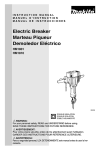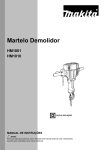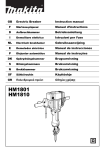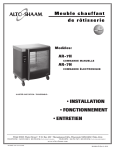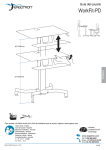Download Makita HM1810 Specifications
Transcript
Makita HM1810 Electric Breaker Supplied by Centenary Hire. Ph: (07) 3375 5068 SPECIFICATIONS Blows per minute: Joules: Net weight: Overall length: 1,100 63 30kg 824mm 5. Avoid body contact with earthed or grounded surfaces such as pipes, radiators, ranges and refrigerators. There is an increased risk of electric shock if your body is earthed or grounded. Intended Use The tool is intended for heavy chiselling and demolition work as well as for driving and compacting with appropriate accessories. Power Supply The tool should be connected only to a power supply of the same voltage as indicated on the nameplate, and can only be operated on single-phase AC supply. They are double-insulated in accordance with European Standard and can, therefore, also be used from sockets without an earth wire. For public low-voltage distribution systems between 220V – 240V Switching operations of electric apparatus cause voltage fluctuations. The operation of this device under unfavourable mains conditions can have adverse effects to the operation of other equipment. With a mains impedance equal or less than 0.31 Ohms it can be presumed that there will be no negative effects. The mains socket used for this device must be protected with a fuse or protective circuit breaker having slow tripping characteristics. Noise A typical A-weighted noise level determined according to EN60745: Sound pressure level (LpA): Sound power level (LWA): Uncertainty (K): Electrical safety 4. Power tool plugs must match the outlet. Never modify the plug in any way. Do not use any adapter plugs with earthed (grounded) power tools. Unmodified plugs and matching outlets will reduce risk of electric shock. 84dB(A) 104dB (A) 2.30dB(A) WEAR EAR PROTECTION Vibration The vibration total value (tri-axial vector sum) determined according to EN60745: Work mode: chiselling Vibration emission (ah,CHeq): 9.0m/s2 Uncertainty(K): 1.5m/s2 The declared vibration emission value has been measured in accordance with the standard test method and may be used for comparing one tools with another. The declared vibration emission value may also be used in a preliminary assessment of exposure. WARNING The vibration emission during actual use of the power tool can differ from the declared emission value depending on the ways in which the tool is used. Be sure to identify safety measures to protect the operator that are based on an estimation of exposure in the actual conditions of use (taking account of all parts pf the operating cycle such as the times when the tool is switched off and when it is running idle in addition to the trigger time). GENERAL POWER TOOL SAFETY WARNINGS WARNING Read all safety warnings and all instructions. Failure to follow all instructions listed below may result in electric shock, fire and/or serious injury. The term “power tool” in all of the warnings listed below refers to your mains operated (corded) power tool or battery-operated (cordless) power tool. Work Area Safety 1. Keep work area clean and well lit. Cluttered and dark areas invite accidents. 2. Do not operate power tools in explosive atmospheres, such as in the presence of flammable liquids, gases or dust. Power tools create sparks which may ignite the dust or fumes. 3. Keep children and bystanders away while operating a power tool. Distractions can cause you to lose control. 6. Do not expose power tools to rain or wet conditions. Water entering a power tool will increase the risk of electric shock. 7. Do not abuse the cord. Never use the cord for carrying, pulling or unplugging the power tool. Keep cord away from heat, oil, sharp edges or moving parts. Electrical safety Damaged or entangled cords increase the risk of electric shock. 8. When operating a power tool outdoors, use an extension cord suitable for outdoor use. Use of a cord suitable for outdoor use reduces the risk of electric shock. Personal safety 9. Stay alert, watch what you are doing and use common sense when operating a power tool. Do not use a power tool while you are tired or under the influence of drugs, alcohol or medication. A moment of inattention while operating power tools may result in serious personal injury. 10. Use safety equipment. Always wear eye protection. Safety equipment such as dust mask, non-skid safety shoes, hard hat, or hearing protection used for appropriate conditions will reduce personal injuries. 11. Avoid accidental starting. Ensure the switch is in the offposition before plugging in. Carrying power tools with your finger on the switch or plugging in power tools that have the switch on invites accidents. 12. Remove any adjusting key or wrench before turning the power tool on. A wrench or a key left attached to a rotating part of the power tool may result in personal injury. 13. Do not overreach. Keep proper footing and balance at all times. This enables better control of the power tool in unexpected situations. 14. Dress properly. Do not wear loose clothing or jewellery. Keep your hair, clothing, and gloves away from moving parts. Loose clothes, jewellery or long hair can be caught in moving parts. 15. If devices are provided for the connection of dust extraction and collection facilities, ensure these are connected and properly used. Use of these devices can reduce dust related hazards. Power tool use and care 16. Do not force the power tool. Use the correct power tool for your application. The correct power tool will do the job better and safer at the rate for which it was designed. 17. Do not use the power tool if the switch does not turn it on and off. Any power tool that cannot be controlled with the switch is dangerous and must be repaired. 18. Disconnect the plug from the power source and/or the battery pack from the power tool before making any adjustments, changing accessories, or storing power tools. Such preventive safety measures reduce the risk of starting the power tool accidentally. 19. Store idle power tools out of the reach of children and do not allow persons unfamiliar with the power tool or these instructions to operate the power tool. Power tools are dangerous in the hands of untrained users. 20. Maintain power tools. Check for misalignment or binding of moving parts, breakage of parts and any other condition that may affect the power tools operation. If damaged, have the power tool repaired before use. Many accidents are caused by poorly maintained power tools. 21. Keep cutting tools sharp and clean. Properly maintained cutting tools with sharp cutting edges are less likely to bind and are easier to control. 22. Use the power tool, accessories and tool bits etc. in accordance with these instructions and in the manner intended for the particular type of power tool, taking into account the working conditions and the work to be performed. Use of the power tool for operations different from those intended could result in a hazardous situation. FUNCTIONAL DESCRIPTION CAUTION • Always be sure that the tool is switched off and unplugged before adjusting or checking function on the tool. Service 23. Have your power tool serviced by a qualified repair person using only identical replacement parts. This will ensure that the safety of the power tool is maintained. Switch action CAUTION • Before plugging in the tool, always check to see that the switch lever actuates properly and returns to the “OFF” position when released. SPECIFIC SAFETY RULES SPECIFIC SAFETY RULES DO NOT let comfort or familiarity with product (gained from repeated use) replace strict adherence to hammer safety rules. If you use this tool unsafely or incorrectly, you can suffer serious personal injury. 1. Wear ear protectors. Exposure to noise can cause hearing loss. To start the tool, simply squeeze the switch lever. Release the switch lever to stop. Indicator lamp The green power-ON indicator lamp lights up when the tool is plugged to the mains. If the indicator lamp is lit but the tool does not start even if the tool is switched ON, the carbon brushes may be worn out, or the motor or the switch may be defective. If the indicator lamp does not light up, the mains cord or the indicator lamp may be defective. 2. Use auxiliary handles supplied with the tool. Loss of control can cause personal injury. 3. Hold tools by insulated gripping surfaces when performing an operation where the cutting tool may contact hidden wiring or its own cord. Contact with a “live” wire will make exposed metal parts of the tool “live” and shock the operator. 4. Wear a hard hat (safety helmet), safety glasses and/or face shield. Ordinary eye or sun glasses are NOT safety glasses. It is also highly recommended that you wear a dust mask and thickly padded gloves. ASSEMBLY CAUTION • Always be sure that the tool is switched off and unplugged before carrying out any work on the tool. Installing or removing the bit This tool accepts bits either with or without a collar on its shank. To install the bit, follow either procedure (1) or (2) described below. 5. Be sure the bit is secured in place before operation. 6. Under normal operation, the tool is designed to produce vibration. The screws can come loose easily, causing a breakdown or accident. Check tightness of screws carefully before operation. 7. In cold weather or when the tool has not been used for a long time, let the tool warm up for a while by operating it under no load. This will loosen up the lubrication. Without proper warm-up, hammering operation is difficult. (1) For bits with a collar Pivot the tool retainer back and slightly downward. Insert the bit into the tool holder as far as it will go. To securely retain the bit, return the tool retainer to its original position. 8. Always be sure you have a firm footing. Be sure no one is below when using the tool in high locations. CAUTION • Always assure that the bit is securely retained by attempting to pull the bit out of the tool holder after completing the above procedure. 9. Hold the tool firmly with both hands. 10. Keep hands away from moving parts. 11. Do not leave the tool running. Operate the tool only when hand-held. 12. Do not point the tool at any one in the area when operating. The bit could fly out and injure someone seriously. 13. Do not touch the bit or parts close to the bit immediately after operation; they may be extremely hot and could burn your skin. 14. Do not operate the tool at no-load unnecessarily. 15. Some material contains chemicals which may be toxic. Take caution to prevent dust inhalation and skin contact. Follow material supplier safety data. WARNING MISUSE or failure to follow the safety rules stated in this instruction manual may cause serious personal injury. OPERATION Chipping/Scaling/Demolition Hold the tool firmly with both hands. Turn the tool on and apply slight pressure on the tool so that the tool will not bounce around, uncontrolled. Pressing very hard on the tool will not increase the efficiency.


